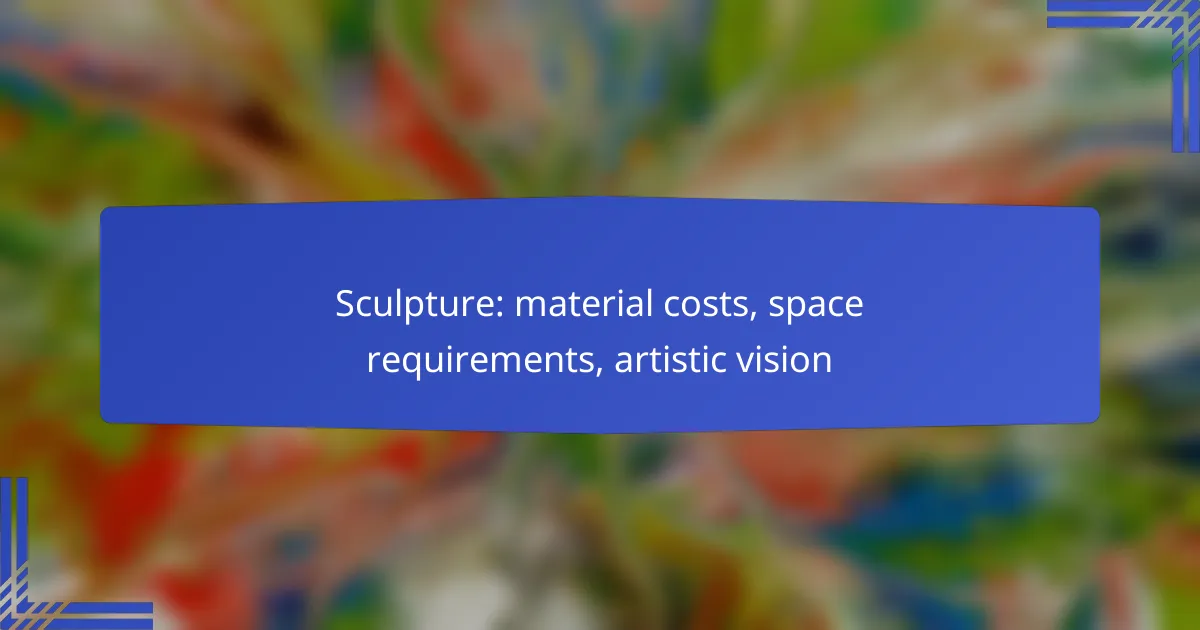Sculpture is a multifaceted art form that involves careful consideration of material costs, space requirements, and the artist’s vision. The choice of materials can greatly influence the budget, ranging from affordable options like clay to pricier choices such as bronze or stone. Additionally, artists need sufficient studio space to work effectively, accommodating both tools and the sculptures themselves. Ultimately, the artistic vision drives the creation process, informing decisions about form, texture, and emotional resonance.

What are the material costs for sculpture in the USA?
The material costs for sculpture in the USA can vary significantly based on the type of materials used and the scale of the project. Artists should budget for a range of expenses, from low-cost options like clay to more expensive materials such as bronze or stone.
Clay costs per pound
Clay is one of the most affordable materials for sculptors, typically costing between $0.50 to $3.00 per pound depending on the type and quality. Artists often choose earthenware, stoneware, or porcelain, each with varying price points and properties.
When budgeting for clay, consider additional costs such as firing and glazing, which can add to the overall expense. A small sculpture might require 10 to 20 pounds of clay, while larger works could need significantly more.
Metal prices for bronze casting
Bronze casting is a popular choice for sculptures but comes with higher costs, often ranging from $4 to $10 per pound for bronze. The final price can also be influenced by the complexity of the casting process and any additional finishing work required.
Artists should factor in costs for mold-making and casting services, which can add hundreds to thousands of dollars to the total project cost. It’s advisable to get quotes from multiple foundries to ensure competitive pricing.
Wood sourcing expenses
Wood can vary widely in price, from $2 to $15 per board foot depending on the species and quality. Common choices for sculpture include oak, maple, and cedar, each offering different aesthetics and durability.
When sourcing wood, consider the cost of tools and finishes, as well as the potential need for treatment against pests or decay. For larger sculptures, the total wood cost can quickly accumulate, so careful planning is essential.
Stone material pricing
Stone is a traditional material for sculpture, with prices ranging from $5 to $50 per cubic foot based on the type of stone, such as marble, granite, or limestone. Each type has unique characteristics that affect both cost and workability.
Transportation and tools for stone carving can significantly increase overall expenses. Artists should account for these additional costs when planning their projects, especially for larger pieces that require more substantial stone blocks.
Budgeting for mixed media
Mixed media sculptures can incorporate a variety of materials, leading to diverse budgeting needs. Costs can vary widely based on the combination of materials used, from inexpensive items like fabric and found objects to pricier components like glass or metal.
When budgeting for mixed media, consider the potential for unexpected expenses, as sourcing unique materials can sometimes lead to higher costs. Keeping a flexible budget can help accommodate these variations while allowing for creative exploration.
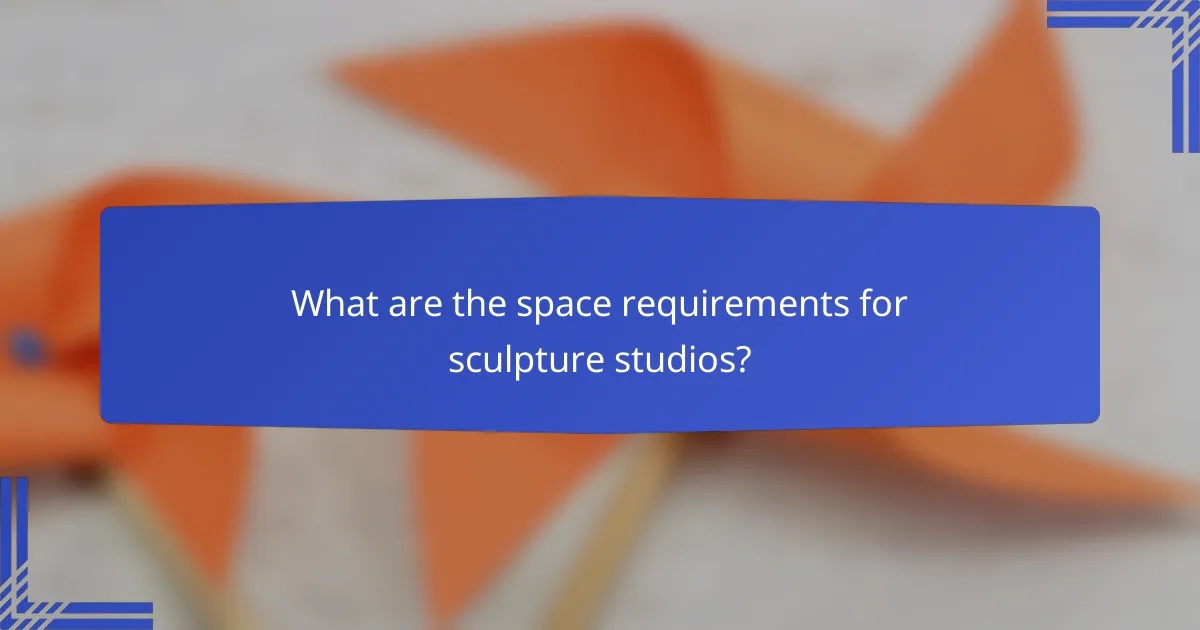
What are the space requirements for sculpture studios?
Sculpture studios require ample space to accommodate tools, materials, and the sculptures themselves. The specific space needed can vary significantly based on the size and type of sculptures being created.
Minimum studio size for large sculptures
For large sculptures, a minimum studio size of around 200 to 300 square feet is often recommended. This space allows for the movement of large pieces and provides room for necessary equipment. Depending on the scale of the work, studios may need to be even larger to facilitate the creation and assembly of substantial sculptures.
Workspace layout for sculpting tools
A well-organized workspace layout is crucial for efficient sculpting. Tools should be easily accessible, with designated areas for different types of equipment such as chisels, hammers, and power tools. Consider using wall-mounted storage or toolboxes to keep the workspace clutter-free and enhance productivity.
Storage needs for materials
Storage for materials is essential in a sculpture studio, especially for those working with various mediums like clay, stone, or metal. Shelving units or cabinets can help keep materials organized and protected from damage. It’s advisable to allocate space for both raw materials and finished pieces, ensuring that everything is easily retrievable when needed.
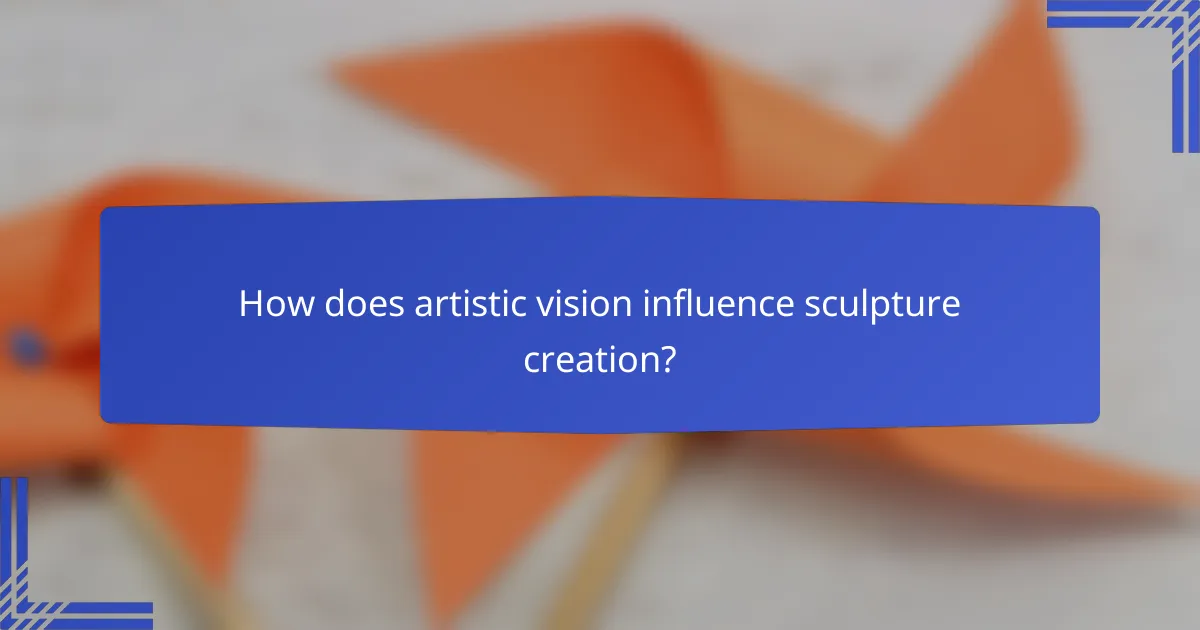
How does artistic vision influence sculpture creation?
Artistic vision is fundamental in sculpture creation as it shapes the concept, materials, and overall execution of the piece. This vision guides artists in making decisions about form, texture, and the emotional impact they wish to convey through their work.
Concept development process
The concept development process is the initial stage where artists brainstorm ideas and themes for their sculptures. This phase often involves sketching, modeling, and exploring various materials to visualize the final piece. Artists may create multiple iterations to refine their vision before committing to a specific direction.
During this process, artists should consider practical aspects such as the intended location of the sculpture and how it will interact with its environment. For instance, a large outdoor piece may require durable materials that can withstand weather conditions, while an indoor work might focus more on intricate details.
Impact of cultural themes
Cultural themes play a significant role in shaping an artist’s vision and the narrative behind their sculptures. Artists often draw inspiration from their heritage, societal issues, or historical events, which can influence the choice of subject matter and style. This connection to culture can enhance the emotional resonance of the work.
When incorporating cultural themes, artists should be mindful of authenticity and representation. Engaging with communities or conducting thorough research can help ensure that the themes are portrayed respectfully and accurately, enriching the sculpture’s significance.
Incorporating personal style
Incorporating personal style is essential for artists to express their unique perspective through sculpture. This can manifest in the choice of materials, techniques, and overall aesthetic. Artists often develop a signature style that sets their work apart and reflects their individual experiences and influences.
To effectively incorporate personal style, artists should experiment with different techniques and materials to discover what resonates with them. Keeping a portfolio of past works can help identify recurring themes and styles, guiding future projects and ensuring consistency in their artistic vision.
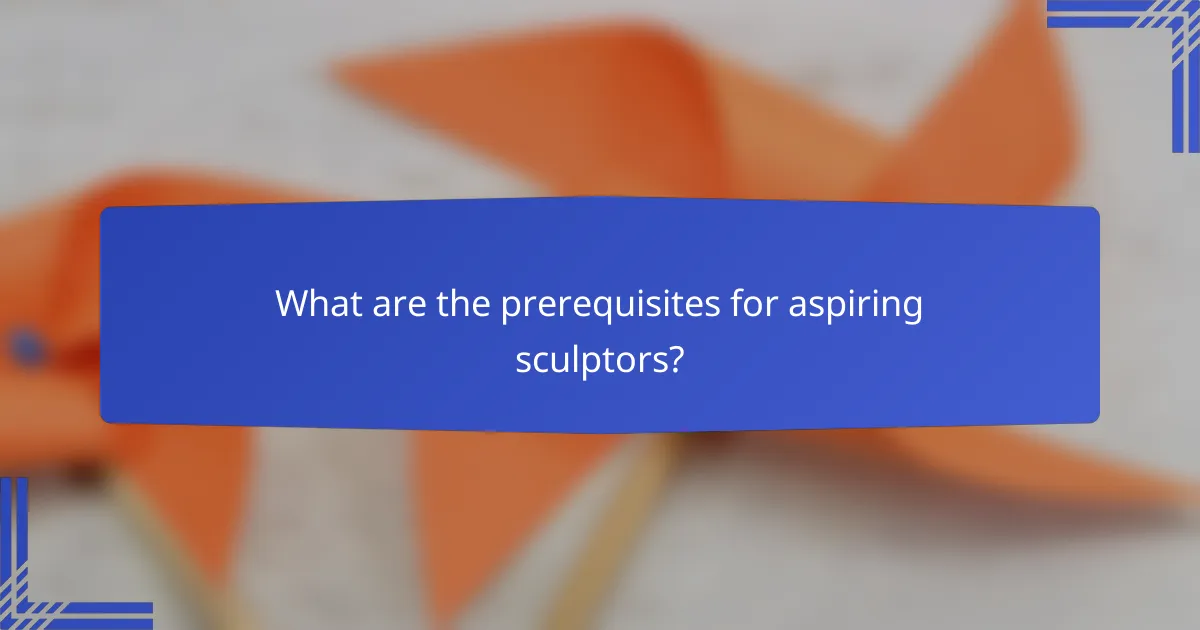
What are the prerequisites for aspiring sculptors?
Aspiring sculptors need a blend of creativity, technical skills, and an understanding of materials. Familiarity with various sculpting techniques and tools is essential, along with a vision for artistic expression.
Essential skills for sculpting
Key skills for sculptors include spatial awareness, hand-eye coordination, and an understanding of anatomy and form. These abilities help in visualizing three-dimensional objects and translating ideas into tangible artworks.
Additionally, proficiency in different materials such as clay, stone, metal, and wood is crucial. Each medium requires specific techniques and tools, so sculptors should experiment to find their preferred materials.
Recommended training programs
Many aspiring sculptors benefit from formal education in fine arts, which often includes courses specifically focused on sculpture. Look for programs that offer hands-on experience and access to various materials and tools.
Workshops and community classes can also provide valuable training. These settings allow for experimentation and feedback from instructors and peers, which can enhance skills and artistic vision.
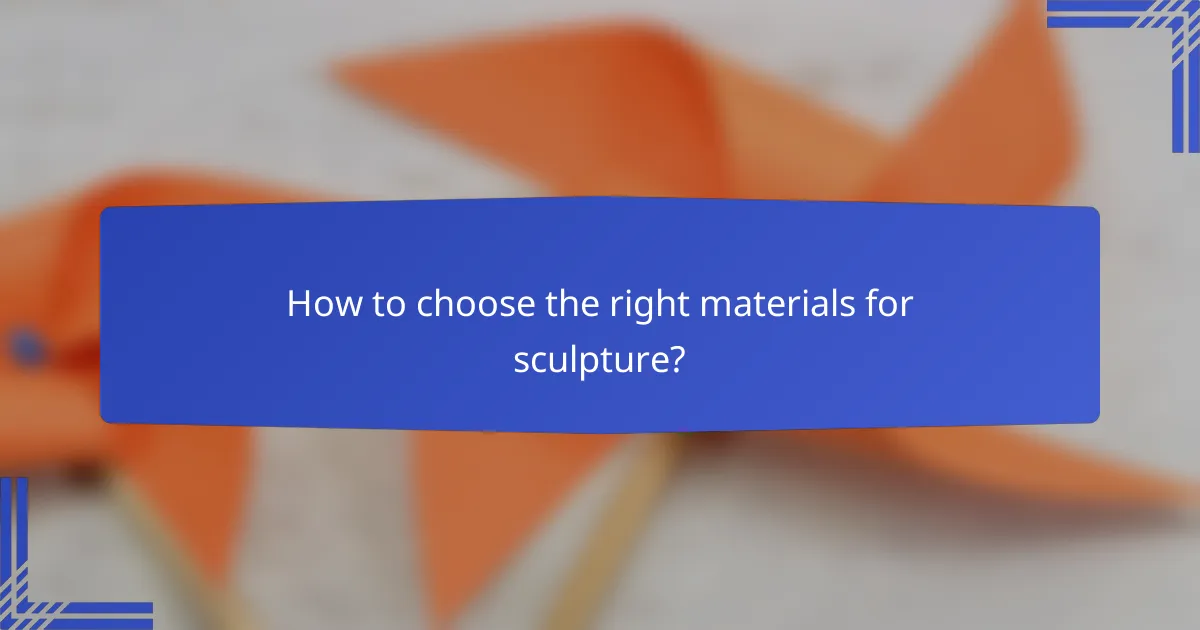
How to choose the right materials for sculpture?
Choosing the right materials for sculpture involves considering durability, aesthetic appeal, and the intended message of the artwork. Artists should evaluate the physical properties of materials, such as weight and texture, alongside their own artistic vision and budget constraints.
Factors influencing material selection
Several factors influence the selection of materials for sculpture, including the environment where the piece will be displayed, the desired longevity, and the overall artistic intent. For outdoor sculptures, weather-resistant materials like bronze or stone are often preferred, while indoor works may utilize wood or resin for their versatility.
Budget is another critical factor; some materials, like marble, can be significantly more expensive than others, such as clay or plaster. Artists should also consider the tools and techniques required for working with specific materials, as this can impact both the cost and the feasibility of the project.
Comparing traditional vs. modern materials
Traditional materials for sculpture, such as stone, wood, and bronze, have been used for centuries and offer a timeless quality. These materials often require specific skills and tools for shaping and finishing, which can be a barrier for some artists.
Modern materials, including plastics, resins, and mixed media, provide new opportunities for creativity and experimentation. They can be lighter and easier to manipulate, but may lack the durability and historical significance of traditional options. Artists should weigh the pros and cons of each type, considering both the technical requirements and the emotional impact of their chosen materials.
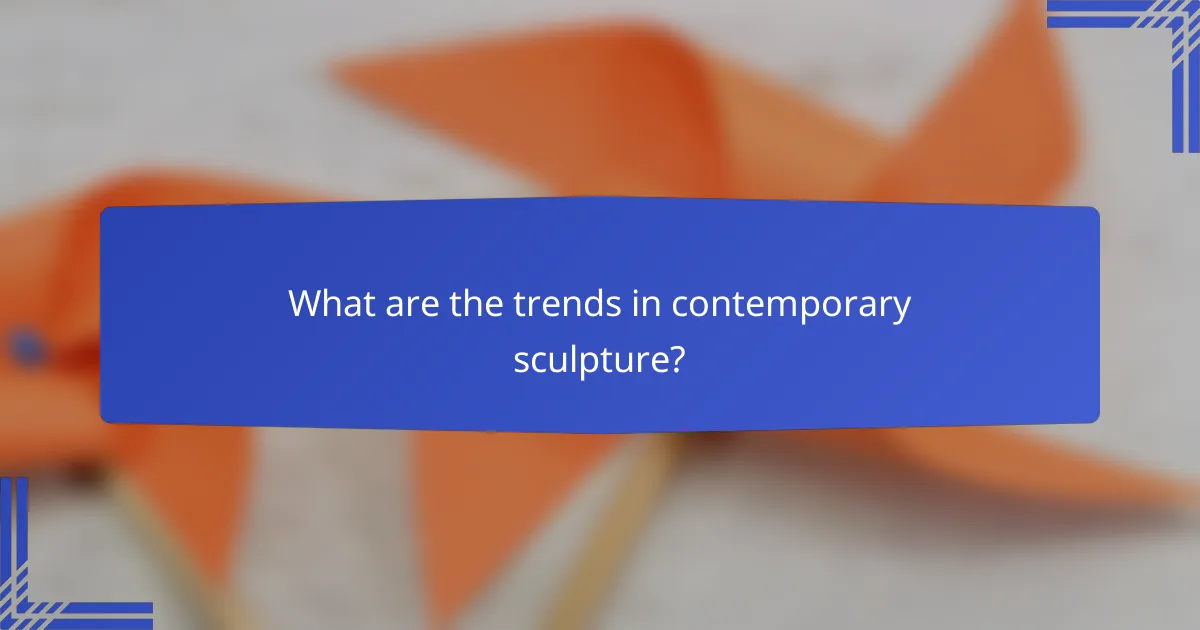
What are the trends in contemporary sculpture?
Contemporary sculpture is increasingly characterized by the use of innovative materials and techniques that challenge traditional forms. Artists are exploring new mediums and methods to express their artistic vision, reflecting current societal themes and environmental concerns.
Emerging materials in sculpture
Artists today are experimenting with a variety of emerging materials, including recycled plastics, bio-based composites, and even digital elements like 3D-printed components. These materials not only offer unique aesthetic qualities but also promote sustainability in art practices.
For instance, using recycled materials can significantly reduce costs and environmental impact, while also resonating with audiences concerned about ecological issues. Artists should consider the availability and durability of these materials, as well as the message they convey through their choice.
Innovative techniques in sculpture
Innovative techniques in contemporary sculpture often involve a blend of traditional craftsmanship and modern technology. Techniques such as laser cutting, CNC machining, and augmented reality are becoming more prevalent, allowing artists to create intricate designs that were previously difficult to achieve.
When adopting these techniques, artists should weigh the benefits of precision and complexity against the potential costs and time involved. Collaborating with specialists in technology can enhance the creative process, but it’s crucial to maintain a clear artistic vision throughout.
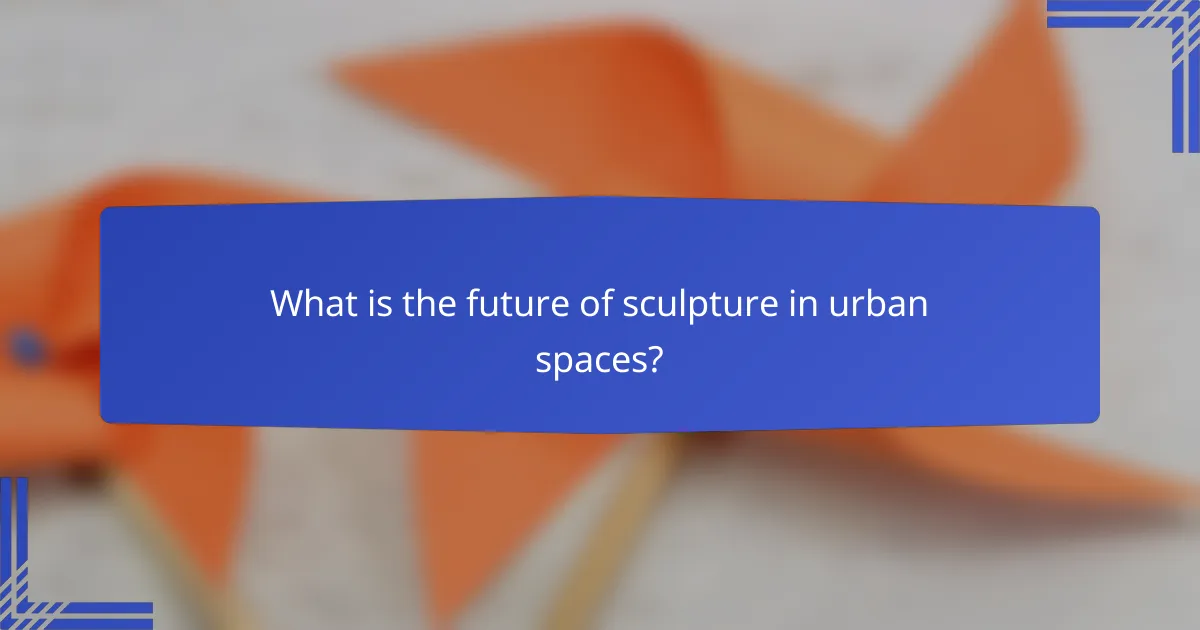
What is the future of sculpture in urban spaces?
The future of sculpture in urban spaces is increasingly focused on integrating art with community needs and environmental sustainability. As cities evolve, sculptures are being designed not only as aesthetic enhancements but also as functional elements that engage the public and reflect local culture.
Material costs
Material costs for urban sculptures can vary widely based on the chosen medium, such as metal, stone, or recycled materials. For instance, traditional materials like bronze may range from several thousand to tens of thousands of dollars, while more modern options like plastics or composites can be more affordable but may require different maintenance considerations.
Budgeting for sculptures should also include installation and maintenance costs, which can add significantly to the overall expenditure. Artists and city planners should collaborate to ensure that the materials used align with both the artistic vision and the financial constraints of the project.
Space requirements
Space requirements for urban sculptures depend on the size and scale of the artwork, as well as its intended interaction with the public. Smaller sculptures may fit comfortably in parks or plazas, while larger installations might need dedicated areas that allow for safe viewing and engagement.
When planning for space, consider factors such as pedestrian traffic, visibility, and the surrounding environment. It’s essential to ensure that the sculpture complements the urban landscape and does not obstruct pathways or create safety hazards.
Artistic vision
The artistic vision for sculptures in urban spaces should reflect the community’s identity and values. Artists are encouraged to engage with local residents to understand their perspectives and incorporate elements that resonate with the public.
Successful urban sculptures often tell a story or provoke thought, making them more than just decorative pieces. Artists should consider how their work interacts with its environment and the emotions it evokes in viewers, ensuring that it contributes positively to the urban experience.
